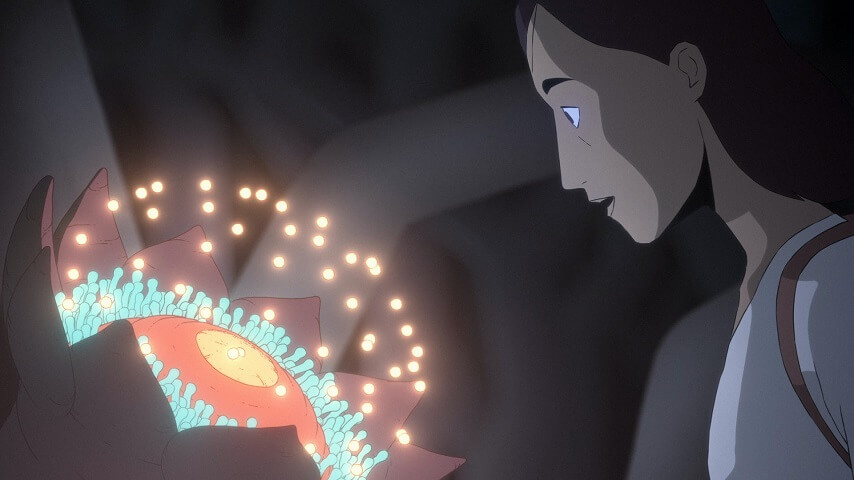It's time to bask in Scavengers Reign's horrifying beauty, you coward
Don't sleep on this truly unique animated sci-fi series, which got a second life on Netflix—and a much-deserved Emmy nod
Scavengers Reign (Image: Warner Bros. Discovery)
When starting a new television show, one of two impulses typically dominates. There’s “I want to see something comforting.” And then there’s that reaction’s darker, more danger-filled, and beautiful sibling: “I want to see some shit I’ve never seen.” Scavengers Reign falls, quite gloriously, in the latter camp.
Originally pitched to Adult Swim, given a shaded existence in the smoke of the rolling garbage fire over at Max, and now getting a bit of genuine sunlight thanks to its move to Netflix and much-deserved Emmy nod, the sci-fi series operates at multiple levels of frequently horrifying joy. But the most basic one is this: Sit down to watch one of its 12 extant episodes, and you’re practically guaranteed to get at least one addition to your personal list of the most fucked-up things you’ve ever seen.
Drawn in soft, gorgeous pastels that deliberately evoke the otherworldly landscapes of French sci-fi legend Moebius, Reign concerns itself with the crew of the Demeter, a space-cargo ship that has the ill fortune to suffer a catastrophic failure in the vicinity of the life-rich world of Vesta. And the thing about the Vestan flora and fauna—as the few survivors who make it to the ship’s escape pods (while most of their comrades remain locked, semi-safe, in cryo sleep) quickly find out—is that they aren’t unwelcoming to human life. Quite the opposite: The Vestan creatures are desperately eager to interface with humanity (as if they need us), whether that means feeding on us, growing inside us, or otherwise adapting us into their all-powerful biological compulsions and needs. You’re going to be part of the system one way or another, Vesta asserts, with snapping teeth, subtle poisons, and slowly creeping tentacles. Adapt or be destroyed.
It’s the show’s greatest selling point that it never makes this overwhelming obsession with adaptation, dependence, and the ugly/glorious things that happen at their intersection either academic or dry to watch. Vesta is, in point of fact, a decidedly wet world, whether you’re watching a psychic scavenger force feed black, oily goo into the mouth of a human survivor, or the show’s most adaptable pair, Sam and Ursula (Bob Stephenson and Sunita Mani), climb through a feeding tube/ovipositor to shelter from a lethal storm in the…womb?…of a sea-faring jellyfish-turtle-thing. (Descriptors get tricky when applied to as varied and fascinating an ecosystem as Vesta sports.) And that’s before we get into the various outright predators and parasites who appear across the planet’s landscapes, which periodically inject a bit of shockingly bright red into the show’s otherwise soft palette with sudden gushes of arterial spray.
We found ourselves wondering—while re-watching the show’s single (and at present final) season on Netflix this week—if James Cameron has seen this shit. Scavengers Reign often feels like a reaction to Cameron’s work. Its opening scenes, and the recurring reminder that “The Company” couldn’t give two shits about its wayward employees, underline the bureaucratic and capitalistic indifference that gives such awful weight to the Alien franchise’s blue-collar vision of space. Vesta, meanwhile, feels like a far more creative, visceral, and real version of Cameron’s too-friendly paradise of Pandora. There is no easy “Our hair connects to their tails!” melding of different biologies here. Even the most beneficial symbiosis in this world comes with undercurrents of horror, the creation of something new requiring the loss of something old.
None of which would work, we’d argue, if the show neglected its human element. It is to the credit of the series’ writers, and especially its cast (which also includes Wunmi Mosaku, Alia Shawkat, and Ted Travelstead) that the survivors, while a bit thinly drawn, come across as real people in a terrifying, occasionally wondrous situation. One of the show’s deeper aims is to demonstrate the way human beings already exist tangled up in systems: co-dependent relationships, guilt complexes, the larger social and financial structures that prey on us each in turn. (When the show introduces a new trio of characters fairly late into its run, it does such a good job of laying the groundwork that it’s impossible not to see them as another form of invasive life, complete with its own unwritten laws and ruling hungers.) And without liking characters like hardened survivor Azi, or even an increasingly deranged martyr like Travelstead’s Kamen, none of the beauty or the horror of those various biological or mental traps would sink its teeth into the show’s viewership.
This will, Eywa willing, continue to grow. Whether you think Scavengers Reign itself deserves or requires a second season—it ends on a note that could easily inspire one but also closes so many of its circles in a satisfying-enough manner as to not require it—it’s something that deserves to be watched for what it already is. Which is like nothing else on TV at the moment: horrifying, warm, philosophical without being pretentious, occasionally funny, and above all creative. Its artists, writers, and performers have put an enormous effort into showing you things you’ve never seen before. Even when its animation looks inexpensive, it never once looks cheap. It has a new idea lurking around every corner, waiting to snare and fascinate you. If your brain is of the type to be fertile soil for it to plant its seeds in, it will do so aggressively and with gusto. We could potentially live without a second season, but we need this team to have more room to make television shows like this one, one way or another. Comfort is cheap, easy, safe. Scavengers Reign is the other thing.
Join the discussion...